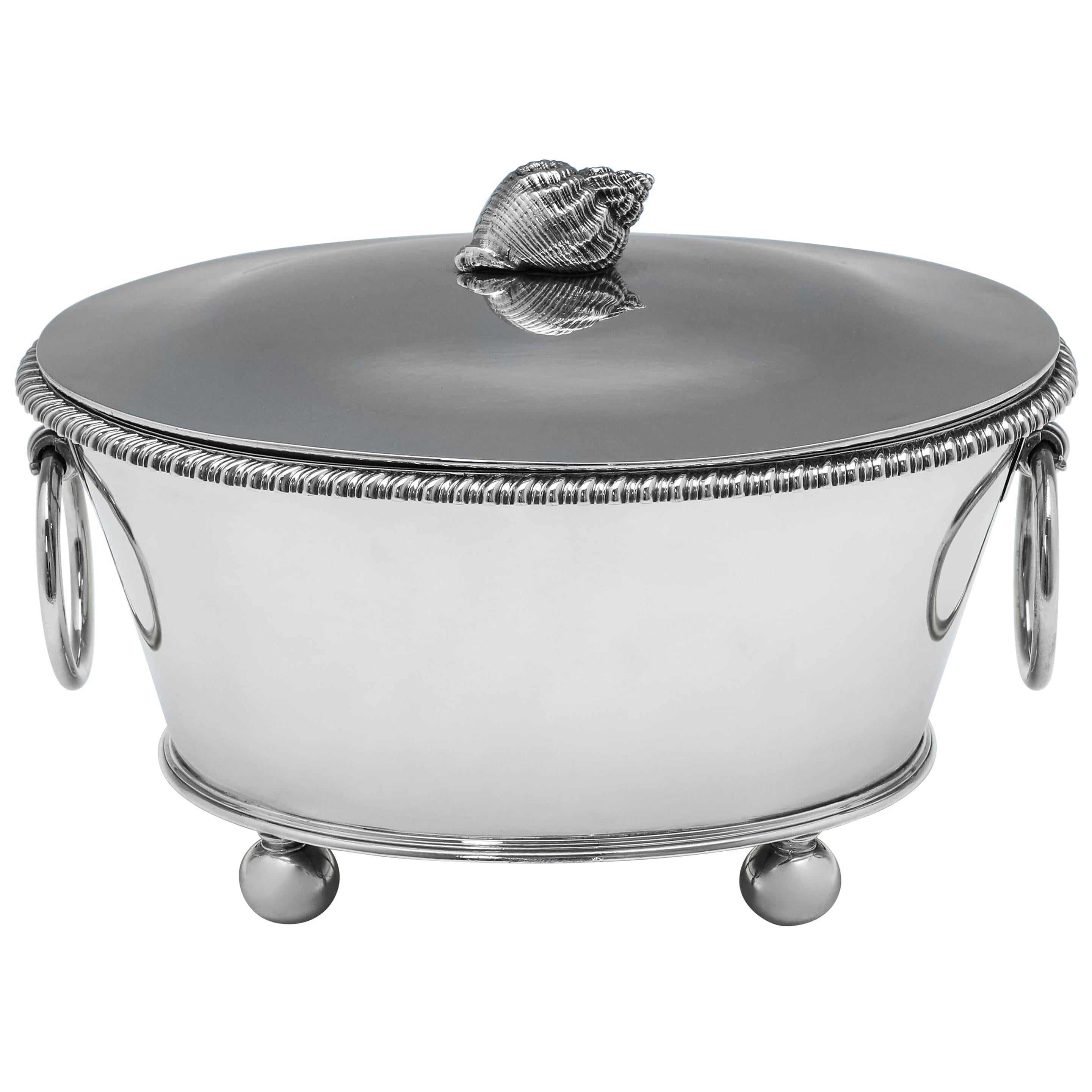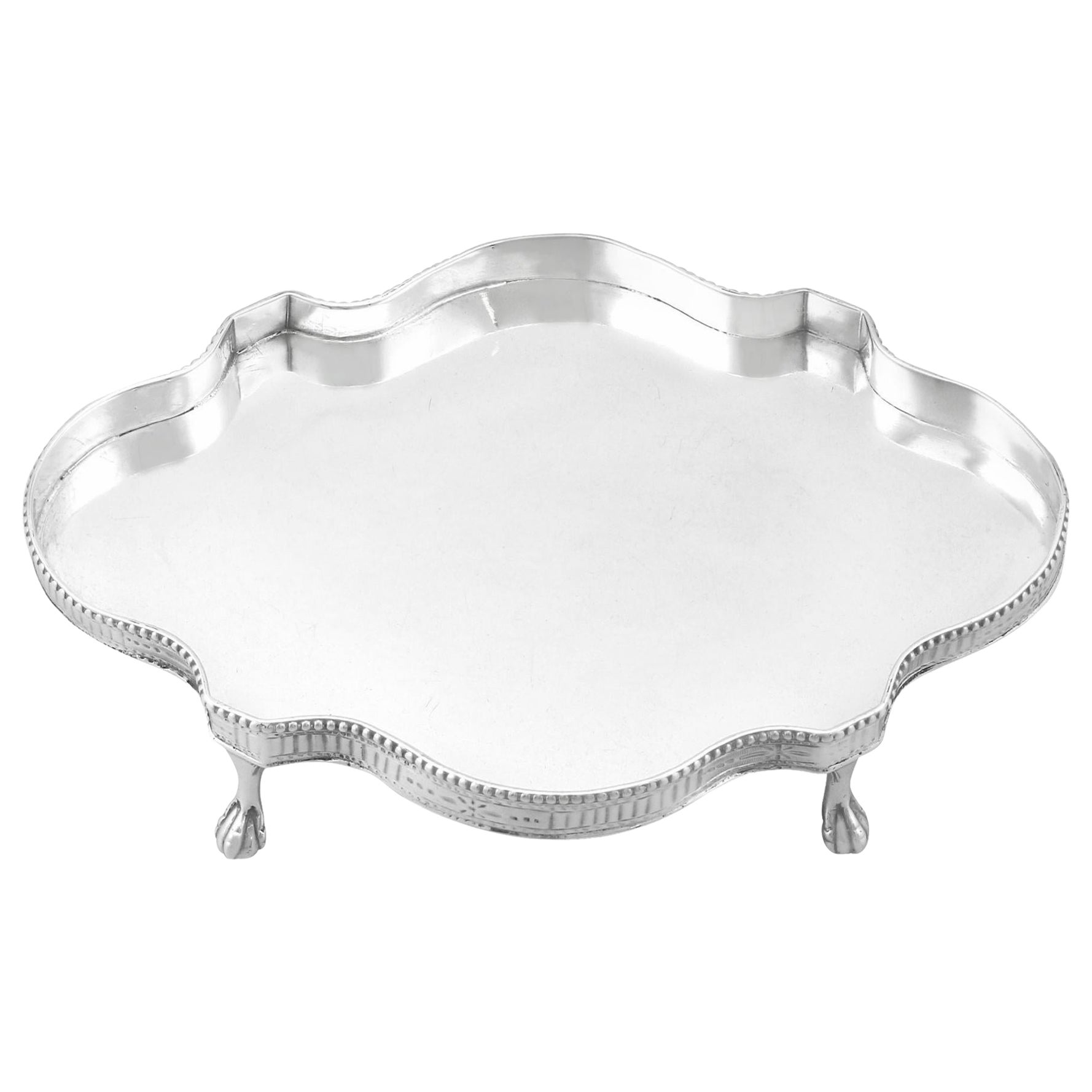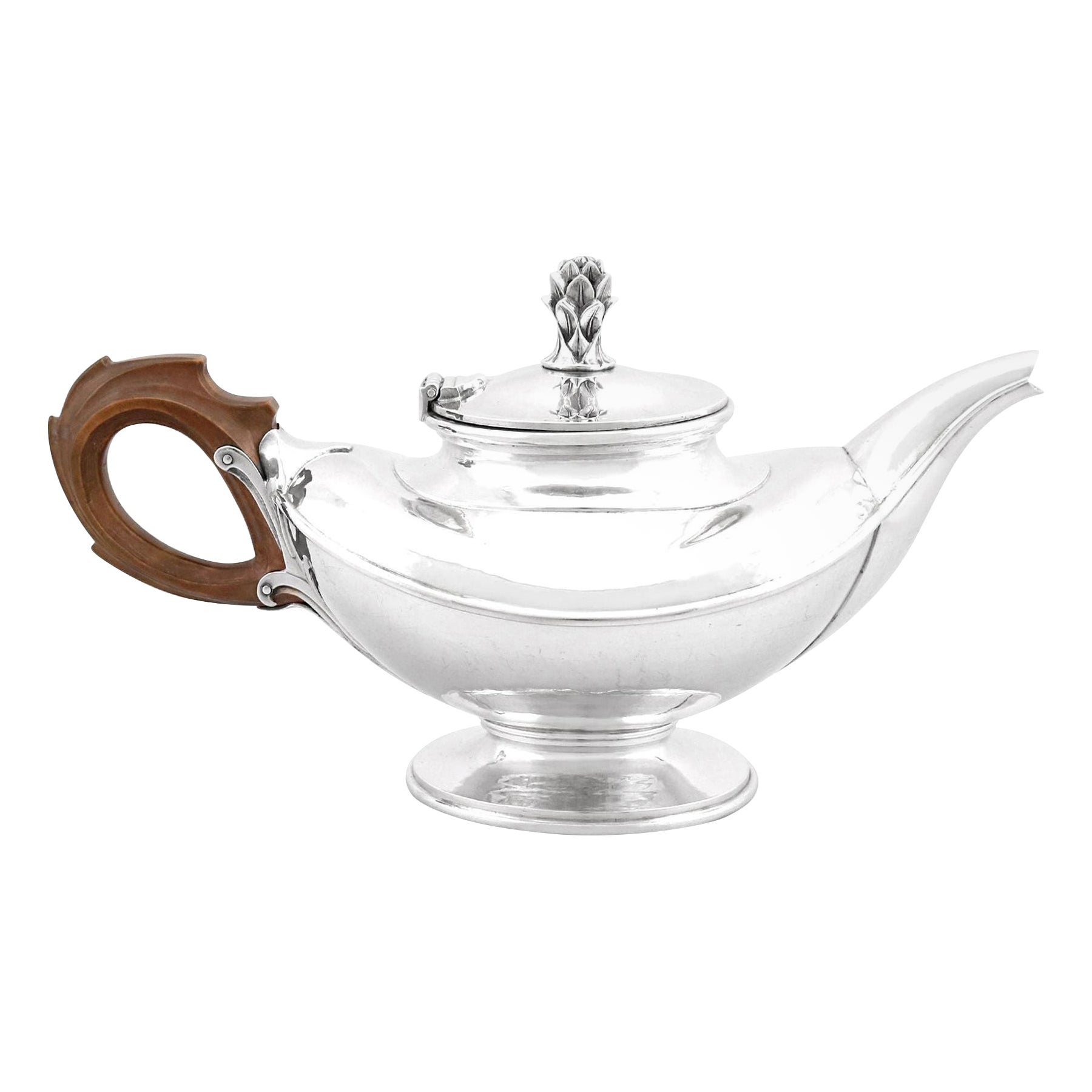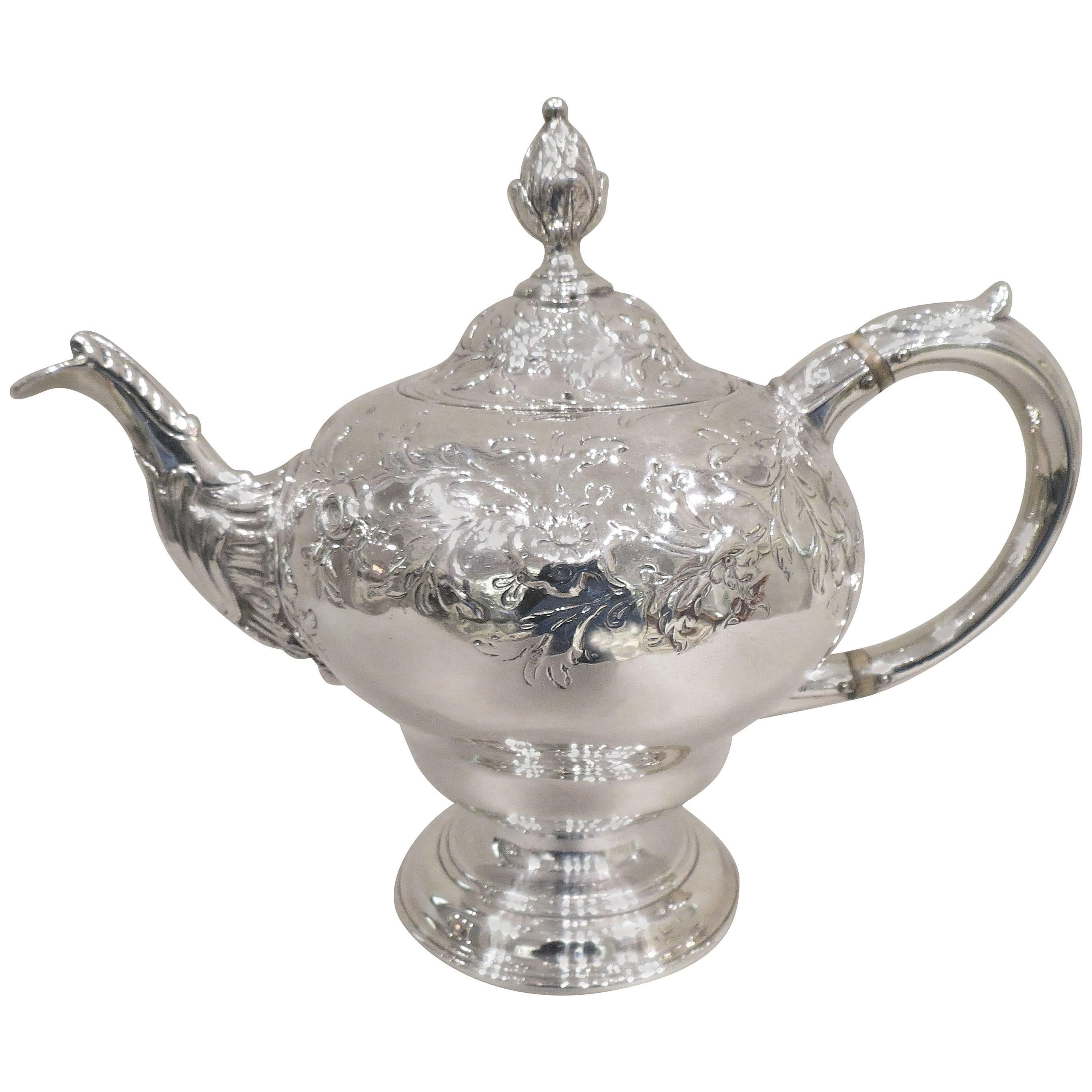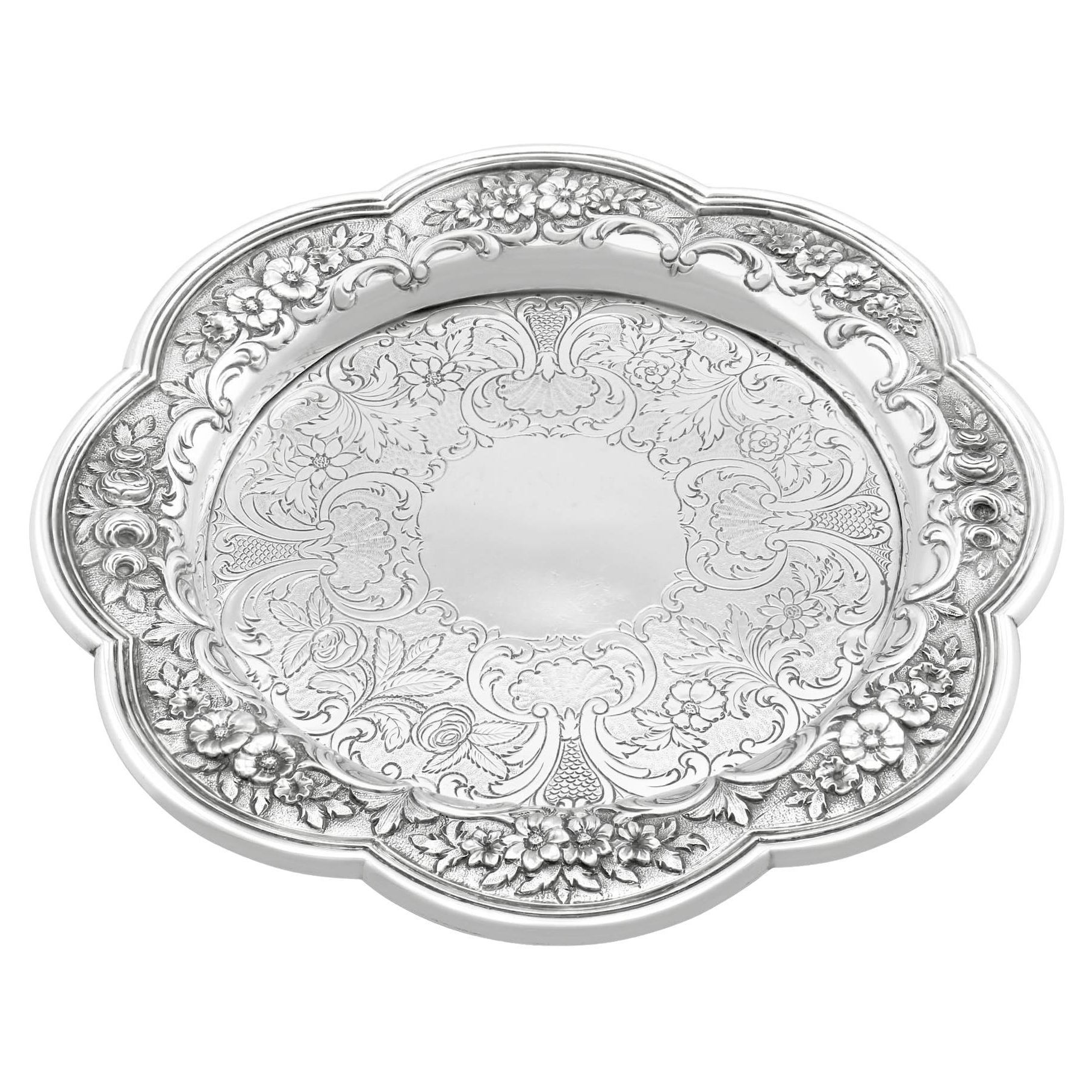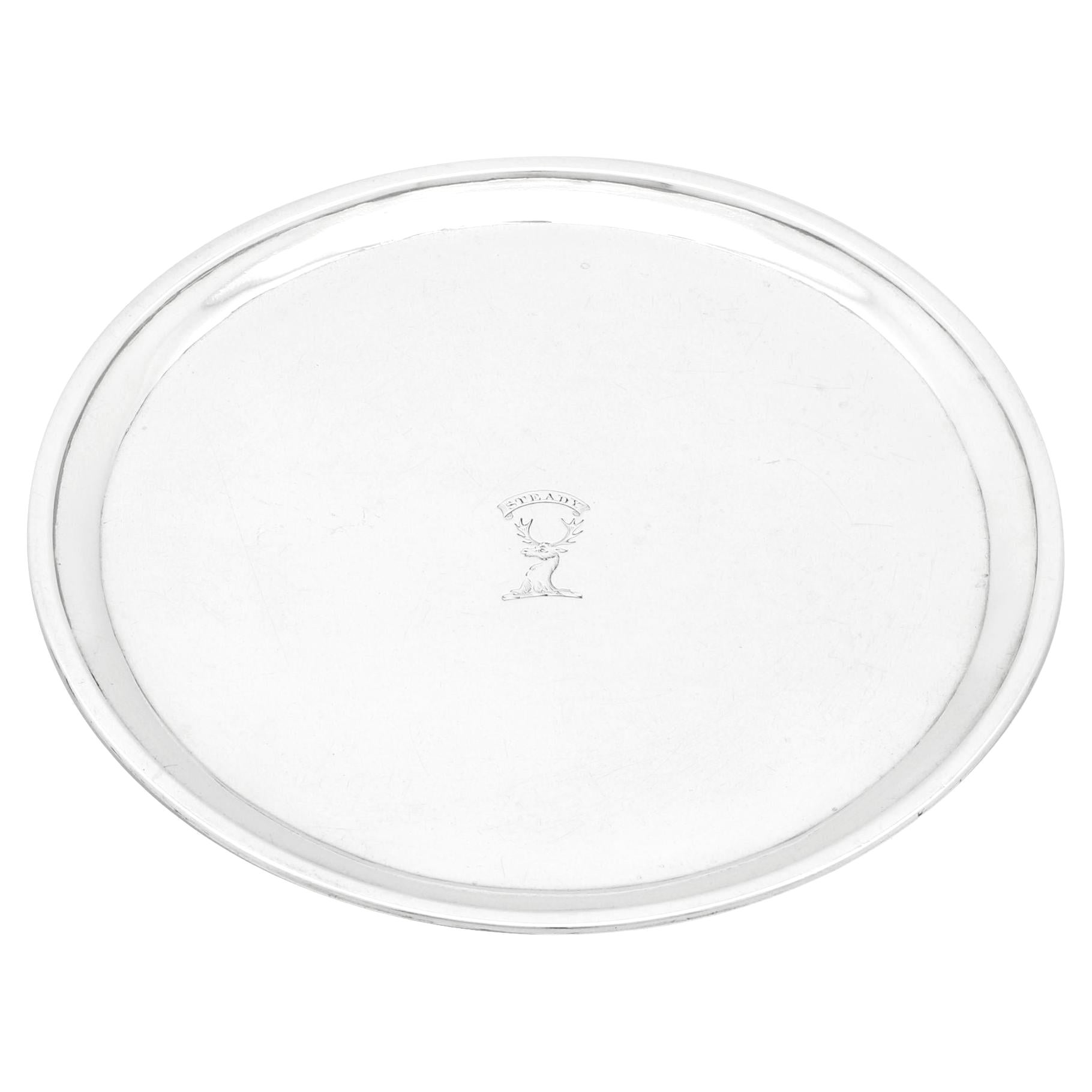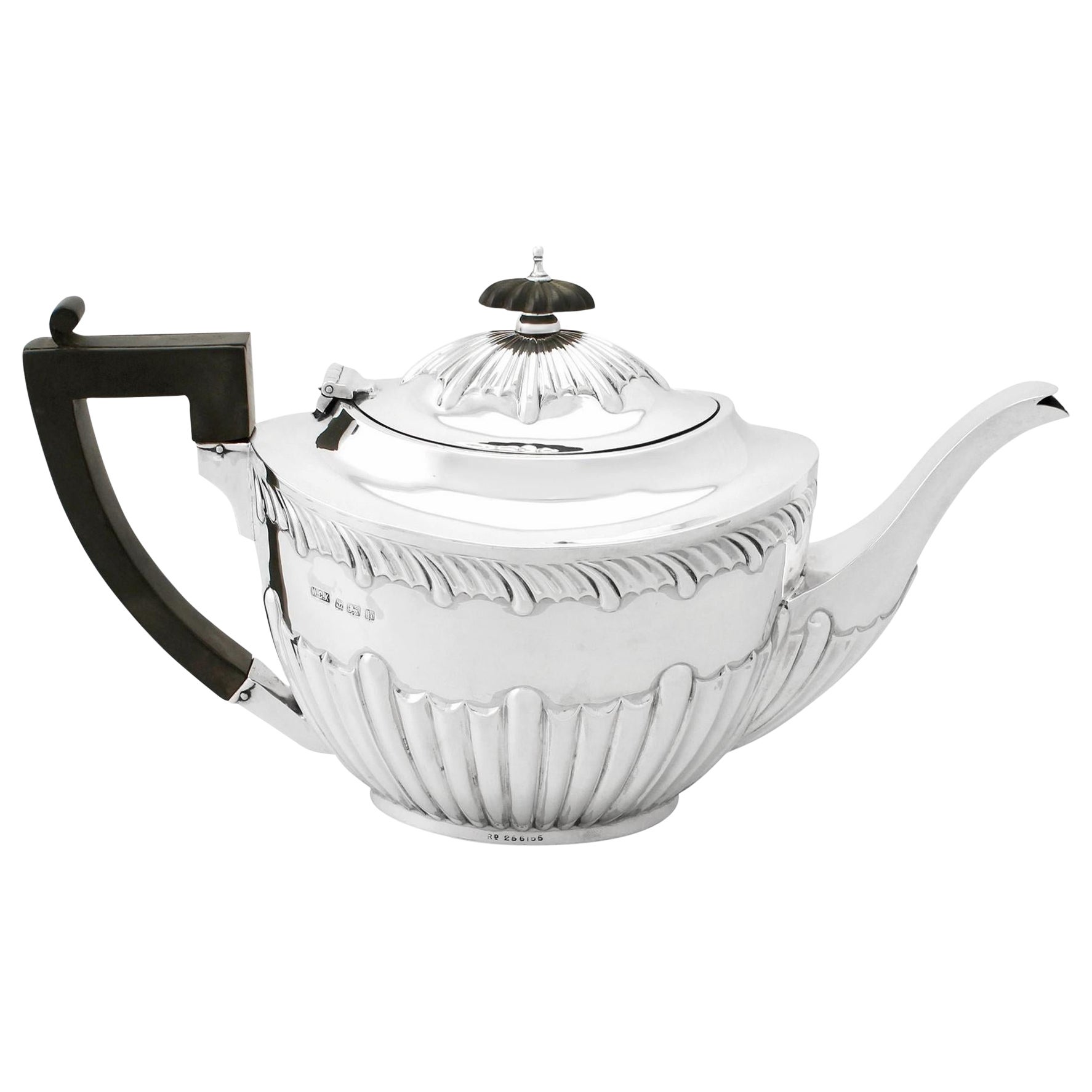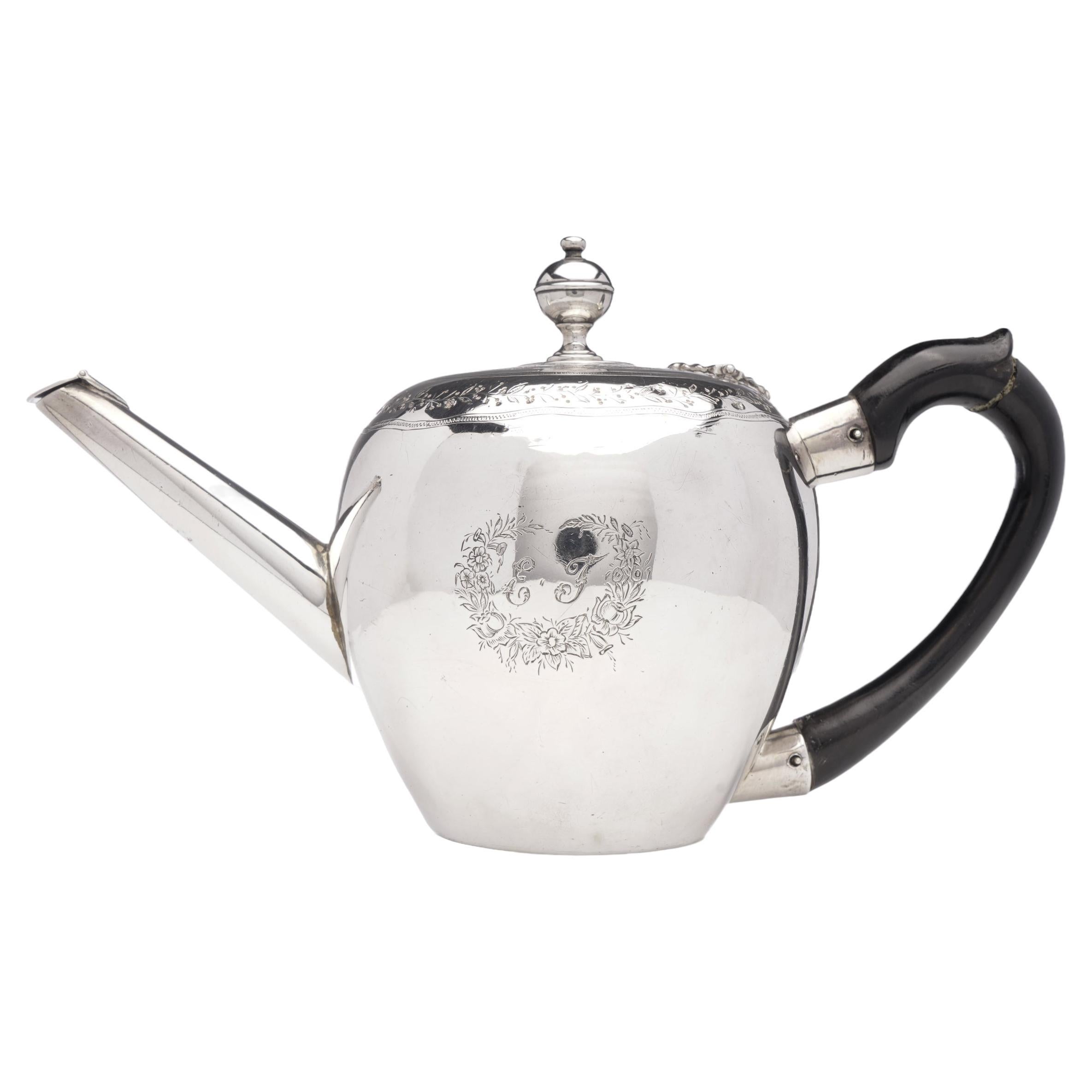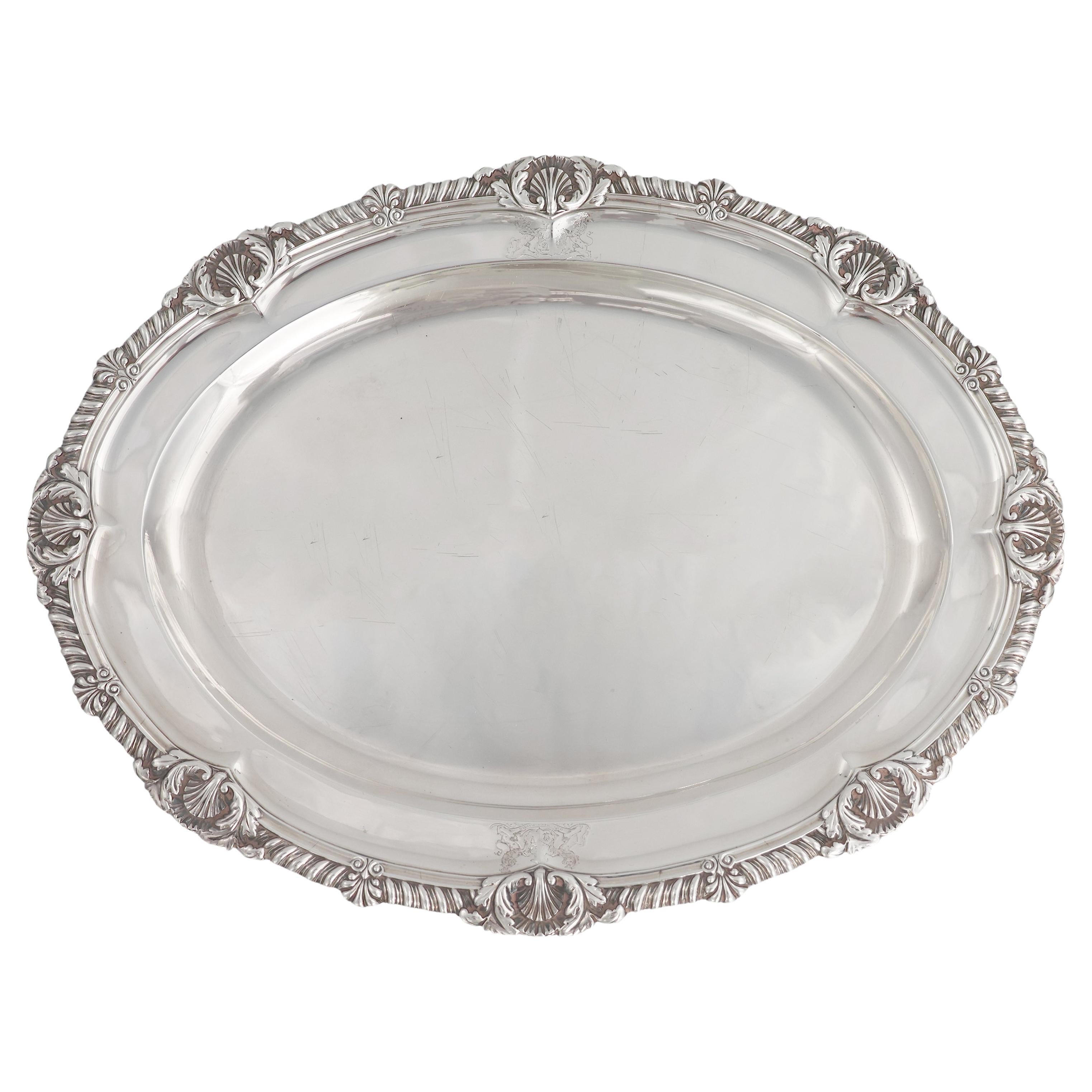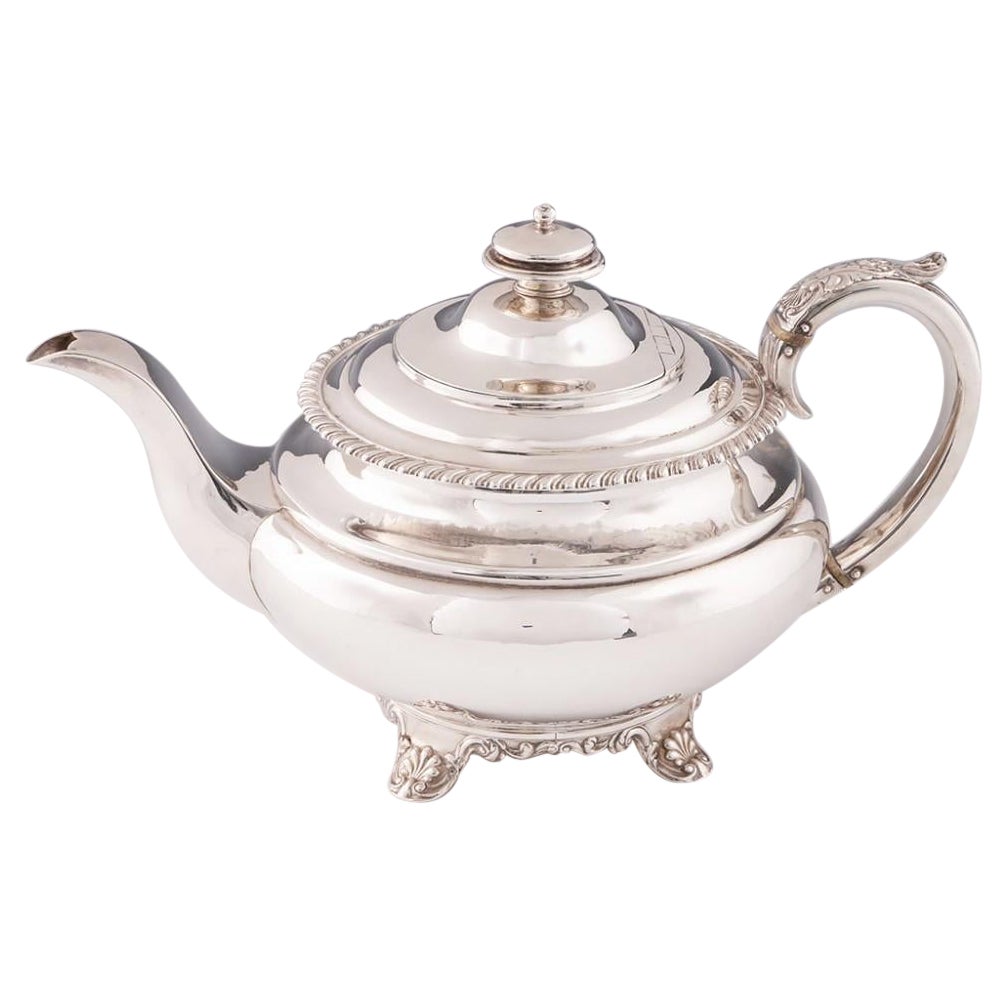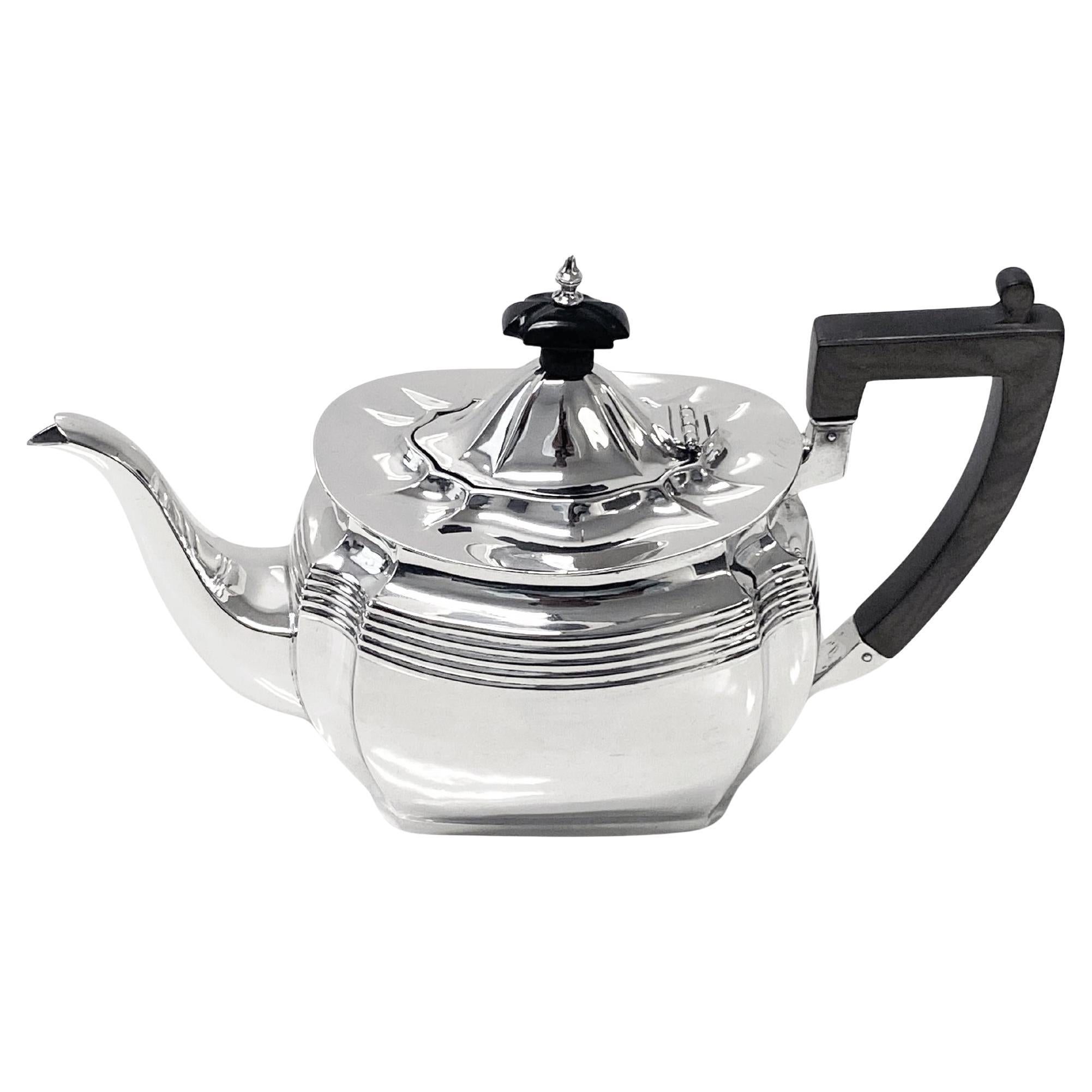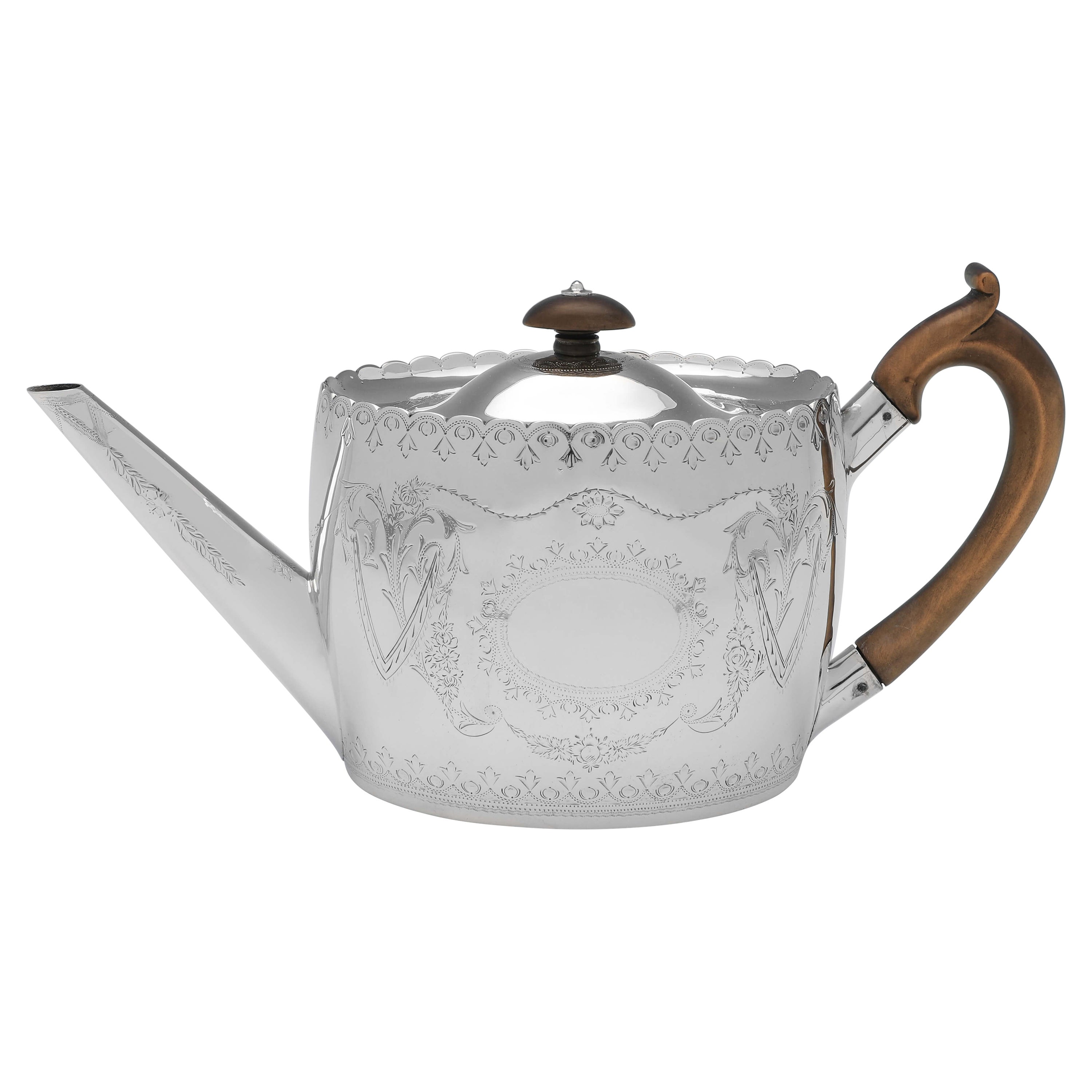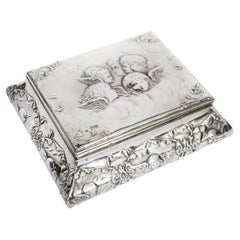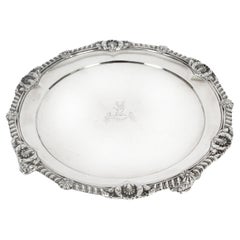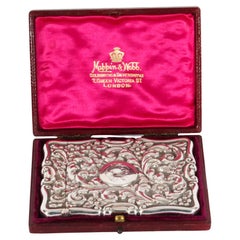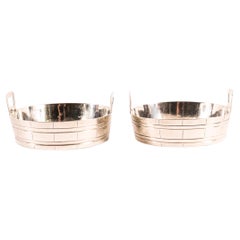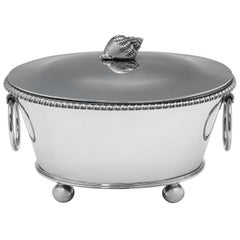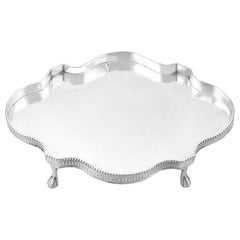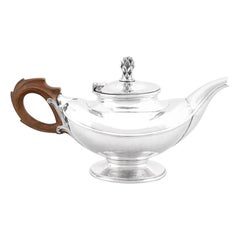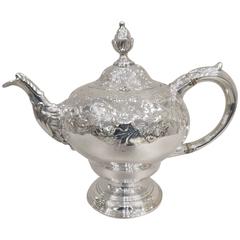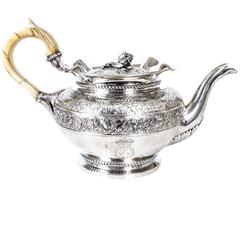
Antique Sterling Silver Teapot by John Bridge, 1825
View Similar Items
Want more images or videos?
Request additional images or videos from the seller
1 of 11
Antique Sterling Silver Teapot by John Bridge, 1825
$3,492.74List Price
About the Item
About the Seller
5.0
Platinum Seller
Premium sellers with a 4.7+ rating and 24-hour response times
Established in 1983
1stDibs seller since 2012
1,389 sales on 1stDibs
Associations
LAPADA - The Association of Arts & Antiques Dealers
Authenticity Guarantee
In the unlikely event there’s an issue with an item’s authenticity, contact us within 1 year for a full refund. DetailsMoney-Back Guarantee
If your item is not as described, is damaged in transit, or does not arrive, contact us within 7 days for a full refund. Details24-Hour Cancellation
You have a 24-hour grace period in which to reconsider your purchase, with no questions asked.Vetted Professional Sellers
Our world-class sellers must adhere to strict standards for service and quality, maintaining the integrity of our listings.Price-Match Guarantee
If you find that a seller listed the same item for a lower price elsewhere, we’ll match it.Trusted Global Delivery
Our best-in-class carrier network provides specialized shipping options worldwide, including custom delivery.More From This Seller
View AllAntique Victorian Sterling Silver Casket by William Comyns & Sons 1898
By William Comyns & Sons 1
Located in London, GB
This is an elegant antique Victorian sterling silver casket with hallmarks for London, 1898 and the makers marks of the renowned silversmith William Comyns & Sons.
The shaped casket...
Category
Antique 19th Century English Victorian Sterling Silver
Materials
Sterling Silver
Antique George III Sterling Silver Salver by Paul Storr 19th Century
By Paul Storr
Located in London, GB
This is a wonderful English antique George III sterling silver 10 inch salver, by the world famous silversmith Paul Storr.
It has clear hallmarks for London 1811 and the makers mark of Paul Storr.
It is typical of his work with the raised gadrooned rim with anthemion at intervals, on four fabulous foliate bracket feet. The salver is engraved with a crest and motto and the underside is later engraved
Charlotte J. Parke from C. J. Parke, March 1893'
The centre is engraved with a crest above a motto 'True and Fast' and I have researched this crest:
The Crest of Parke
The crest as engraved upon this George III English Sterling Silver Footed Salver by Paul Storr hallmarked London 1811 is that of the family of Parke. It may be blazoned as follows:
Crest: A stag’s head couped sable holding in the mouth a key or
Motto: True and fast
The family of Parke originally hailed from the County of Cumberland in the northeast of England1 later settling in the County of Dorset at Henbury House, Sturminster Marshal, near Wimborne. Given the evidence of the inscription found on the underside of the salver ‘Charlotte J. Parke from C. J. Parke, March 1893’ it was undoubtedly at one time in the possession of Charles Joseph Parke (died 9th March 1893) of Henbury House aforesaid and gifted to Charlotte Josephine Parke (baptised 4th January 1857 died 2nd January 1941) his third daughter by his wife, Ellen Mary Ethelston. I would venture the following hypothesis that the salver was bequeathed to Charlotte in her father’s will that was granted probate at London on the 20th May 1893. The ‘March 1893’ of the inscription acts as a remembrance of the month of the death of her father. It was noted that Charlotte’s father left an estate worth some £66,892, 19 shillings and one pence, a very considerable sum in the last decade of the 19th Century and even thereafter. Charlotte never married and was living at the time of her death at The Coppice, Sixpenny Handley in the County of Dorset. Her will was proved for probate at Llandudno on the 25th March 1941. She left an estate worth £18,866, 10 shillings and 4 pence. Again, a comfortable sum in 1941.
See the photo of Henbury House, Sturminster Marshal, near Wimborne, Co. Dorset. The former seat of the Parke family. The house was destroyed by fire, the remains of which were demolished in the 1990's.
There is no mistaking its unique quality and design, which is sure to make it a treasured piece by any discerning collector.
Condition:
In excellent condition with clear hallmarks and no dings, dents or signs of repair. Please see photos for confirmation.
Dimensions in cm:
Height 2 x Width 26.5 x Depth 26.5
Weight 0.69 kg
Dimensions in inches:
Height 1 inch x Width 10 inches x Depth 10 inches
Weight 1.5 lbs
Paul Storr
born in London England in 1771, was to become one of the most talented silversmiths of the nineteenth century. Today his legacy of exceptionally well crafted silver, found worldwide in museums and private collections, leaves one in awe when compared to that of his contemporaries.After having served a seven year apprenticeship from the age of 14, he began his career in 1792 when he went into a brief partnership with William Frisbee. This did not last and in 1793 a new mark, (his initials ‘P S’) was entered. By the beginning of the nineteenth century he had established himself as one of London’s top silversmiths producing, amongst others, commissions for Royalty.
In 1801 he married Elizabeth Susanna Beyer with whom he was to have ten children. In 1807 Paul Storr entered into a working relationship with Philip Rundell and by 1811 was a partner, and managing the workshops for Rundell, Bridge & Rundell.
During this period he kept his own marks and separate workshop. However it was through Rundell, Bridge & Rundell who were appointed Goldsmith in Ordinary to George III in 1804 that his reputation as a master silversmith grew. His talents lay in being able to transform ideas and designs from Rundell, Bridge & Rundell’s designers, William Theed...
Category
Antique 1810s English George III Sterling Silver
Materials
Sterling Silver
Antique English Sterling Silver Card Case Mappin & Webb 1904
By Deakin & Francis
Located in London, GB
This is a stylish antique Edwardian sterling silver card case with hallmarks for Birmingham 1904 and the makers mark of the renowned silversmiths Deakin & Francis Ltd, in the origina...
Category
Antique Early 1900s English Edwardian Sterling Silver
Materials
Sterling Silver
Antique Pair Victorian Sterling Silver Butter Dishes Dated 19th Century
Located in London, GB
This is a very attractive pair of antique Victorian sterling silver dishes / coasters with hallmarks for London 1890.
They feature attractive faux-coopered decoration with a handle...
Category
Antique Late 19th Century English Victorian Sterling Silver
Materials
Sterling Silver
Vintage English Oval Sterling Silver Photo Frame by Carrs Sheffield 1986 20th C
By Carrs of Sheffield 1
Located in London, GB
Truly superb Vintage sterling silver photo frame bearing the makers mark of Carrs of Sheffield and hallmarks for Sheffield 1986.
The horizontal oval frame has a blue velvet back with plain border decorated and features easel back.
An elegant design for your most cherished photograph.
Condition:
In excellent condition, please see photos for confirmation
Dimensions in cm:
Height 17 x width 13 x depth 2
Height 13.5 x width 9 - Photo aperture
Dimensions in inches:
Height 7 inches x width 5 inches x depth 1 inch
Height 5 inches x width 3 inches - Photo aperture
Carrs Silver is a prestigious silverware brand, world-renowned for our values of quality and design. We started our journey back in 1976 when our founder, Ron Carr, left his factory position in Sheffield to craft silver jewellery...
Category
Vintage 1980s English Sterling Silver
Materials
Sterling Silver
Vintage 12 Place Kings Pattern Sterling Silver Cutlery by Harrods 20th Century
By Gee & Holmes
Located in London, GB
A superb and rare complete Elizabeth II walnut cased, 117 piece, twelve place canteen of flatware cutlery, in the elegant Kings pattern, retailed by Harrods Knightsbridge London and bearing hallmarks for Sheffield, 1963 and the makers mark of Gee & Holmes.
Comprising:
twelve table forks,
twelve dessert forks,
twelve dessert spoons,
twelve soup spoons,
twelve teaspoons,
twelve fish knives with silver blades
twelve fish forks with silver tines,
twelve table forks,
twelve dessert knives
six table spoons
three piece fork set
All contained in the original superb fitted walnut canteen box with hinged lid and a single fitted drawer and custom fitted in blue felt. It bears the label "Harrods Ltd Cutlers & Silversmiths, Knightsbridge, S.W."
This is the complete set, it is highly unusual to find such a nice patterned set with not even a single piece missing!
Condition:
In excellent condition, please see photos for confirmation.
Dimensions in cm:
Height 19 cm x Width 50 cm x Depth 35.5 cm - Canteen case
Weight 5.44 kg
Dimensions in inches:
Height 7 inches x Width 1 foot, 8 inches x Depth 1 foot, 2 inches - Canteen case
Weight 175 troy oz
Harrods
founder Charles Henry Harrod first established his business in 1824, aged 25. The business was located south of the River Thames in Southwark. The premises were located at 228 Borough High Street.
He ran this business, variously listed as a draper, mercer and a haberdasher, certainly until 1831. During 1825 the business was listed as 'Harrod and Wicking, Linen Drapers, Retail', but this partnership was dissolved at the end of that year. His first grocery business appears to be as ‘Harrod & Co.Grocers’ at 163 Upper Whitecross Street, Clerkenwell, E.C.1., in 1832. In 1834 in London's East End, he established a wholesale grocery in Stepney, at 4, Cable Street, with a special interest in tea.
In 1849, to escape the vice of the inner city and to capitalise on trade to the Great Exhibition of 1851 in nearby Hyde Park, Harrod took over a small shop in the district of Brompton, on the site of the current store. Beginning in a single room employing two assistants and a messenger boy, Harrod's son Charles Digby Harrod built the business into a thriving retail operation selling medicines, perfumes, stationery, fruit and vegetables. Harrods rapidly expanded, acquired the adjoining buildings, and employed one hundred people by 1880.
However, the store's booming fortunes were reversed in early December 1883, when it burnt to the ground. Remarkably, in view of this calamity, Charles Harrod fulfilled all of his commitments to his customers to make Christmas deliveries that year—and made a record profit in the process. In short order, a new building was built on the same site, and soon Harrods extended credit for the first time to its best customers, among them Oscar Wilde,Lillie Langtry, Ellen Terry, Charlie Chaplin, Noël Coward, Gertrude Lawrence, Laurence Olivier and Vivien Leigh, Sigmund Freud, A. A. Milne, and many members of the British Royal Family.
On Wednesday, 16 November 1898, Harrods debuted England's first "moving staircase" (escalator) in their Brompton Road stores; the device was actually a woven leather conveyor belt-like unit with a wood and "silver plate-glass" balustrade. Nervous customers were offered brandy at the top to revive them after their 'ordeal'. The department store was purchased by the Fayed brothers in 1985.
In 2010 Harrods was sold to Qutar Holdings.
Harrods was the holder of royal warrants from 1910 till 2000 from the following:
* Queen Elizabeth II (Provisions and Household Goods)
* The Duke of Edinburgh (Outfitters)
* The Prince of Wales (Outfitters and Saddlers)
* The late Queen Elizabeth, the Queen Mother (China and Glass)
The store occupies a 5-acre (20,000 m2) site and has over one million square feet (90,000 m2) of selling space in over 330 departments making it the biggest department store in Europe.
The UK's second-biggest shop, Selfridges, Oxford Street, is a little over half the size with 540,000 square feet (50,000 m2) of selling space, while the third largest, Allders of Croydon had 500,000 square feet (46,000 m2) of retail space.
By comparison Europe's second-largest department store the KaDeWe in Berlin has a retail space of 650,000 square feet (60,000 m2).
GEE & HOLMES LTD
This enterprise can be traced to the registration of Thomas Raynes Ltd as a private limited company in 1935. Capitalised at £1,000, it was based at 39 Eyre Street, and dealt in cutlery and various tools. The subscribers were brothers: James Fairclough Gee (1899-1974) and Reginald L. Gee (1913-?). They had been born at St Helens, Lancashire, the sons of James Gee (1868-1948) – an insurance superintendent – and his wife, Agnes née Fairclough. In 1939, James and Reginald Gee were living with their parents at 47 Brooklands Crescent. They were described in the Register of England & Wales (1939) as cutlery manufacturers. Also residing at Brooklands Crescent (62) was Leonard Wycliffe Holmes (1901-1989), his wife Florence, and their son, James Geoffrey (1932-1985). Leonard had been born in Sheffield, the son of John Clement Holmes (a steel and iron turner) and his wife, Bertha née Shelton. Leonard apparently received a technical education, as in 1920 he co-presented a paper on electro-plating at Mappin Hall. He held an Associateship in Metallurgy from Sheffield University (Sheffield Daily Independent, 19 November 1920). Leonard and Florence had been married at a Wadsley Church in 1927: she was the sister of James F. Gee. In 1939, Leonard was working as a commercial traveller in cutlery.
During the Second World War, Thomas Raynes Ltd was listed at 41 Arundel Street – the same address as cutlery manufacturer, L. Holmes & Co. The Hawley Collection has a stainless table knife marked ‘L. Holmes & Co’, which was probably made at this time. Thomas Raynes Ltd became the vehicle for a new business entity – Gee & Holmes Ltd – which initially occupied 41 Arundel Street. In an advertisement in 1946, the partners announced that they would be moving into a new factory at 61 Eyre Lane in early 1947. The two-storey factory, which became known as Heritage Works, was bounded by Eyre Lane and Newton Lane. Gee and Holmes...
Category
20th Century English Elizabethan Sterling Silver
Materials
Sterling Silver
You May Also Like
George IV Antique Sterling Silver Bouillabaisse Tureen by John Bridge, 1825
By John Bridge
Located in London, London
Hallmarked in London in 1825 by John Bridge, this stylish, George IV, antique sterling silver Bouillabaisse Tureen, stands on four ball feet, and features a shell finial to the lid, ...
Category
Antique 1820s English George IV Sterling Silver
Materials
Sterling Silver
John Langlands I & John Robertson I Newcastle Sterling Silver Teapot Stand
By John Langlands I & John Robertson I
Located in Jesmond, Newcastle Upon Tyne
A fine and impressive antique Georgian Newcastle sterling silver teapot stand made by John Langlands I & John Robertson I; an addition to ...
Category
Antique 1780s English George III Sterling Silver
Materials
Sterling Silver
Omar Ramsden Antique Sterling Silver Teapot
By Omar Ramsden
Located in Jesmond, Newcastle Upon Tyne
An exceptional, fine and impressive antique George V English sterling silver teapot made by Omar Ramsden; an addition to our collectable silver teaware collection.
This exceptional antique George V English sterling silver teapot has an oval boat shaped form to an oval pedestal foot.
The surface of this Omar Ramsden silver teapot has a subtly planished finish and is encircled with an applied moulded girdle, in addition to applied moulded decoration to the upper rim.
This fine example of antique silverware is fitted with the original hallmarked subtly domed hinged cover which retains the original and impressive cast sterling silver pineapple...
Category
Vintage 1930s British Tableware
Materials
Sterling Silver
Antique Sterling 925/°°° Silver Finely Chased Teapot
Located in Torino, IT
Manufactured by Charles Wright, London, England, 1771.
Category
Antique 1770s English Sterling Silver
Materials
Sterling Silver
Antique Victorian Scottish Sterling Silver Teapot Stand
By James McKay
Located in Jesmond, Newcastle Upon Tyne
An exceptional, fine and impressive antique Victorian Scottish sterling silver teapot stand; an addition to our ornamental silverware collection.
...
Category
Antique 1830s Scottish Sterling Silver
Materials
Sterling Silver
Antique Scottish Sterling Silver Waiter Teapot Stand
By William Robertson
Located in Jesmond, Newcastle Upon Tyne
A fine and impressive antique George IV Scottish sterling silver waiter/teapot stand; an addition to our ornamental silverware collection.
This fine antique George IV sterling silver waiter has a plain circular form onto a circular collet foot.
The surface of this fine example of Scottish silverware is embellished with a fine and impressive contemporary bright cut engraved crest depicting a stag's head erased below the motto 'Steady'.
The swept border is ornamented with a plain applied moulded rim.
This crest pertains to the family name M'Adam, McAdam and Macadam of Craigengillan, Ayrshire, Scotland.
Condition
This antique teapot stand...
Category
Antique 1820s Scottish George IV Platters and Serveware
Materials
Silver, Sterling Silver
Recently Viewed
View AllMore Ways To Browse
Crest Watch
Thomas Ivory
King George Silver Box
Bombay Jewelry Box
3 Piece Sterling Silver Teapot
Tiara Glass
American Snuff Box
George Iii Sterling Silver Teapot
Silver Bridge Box
Ivory Snuff Box
Benjamin Smith
Benjamin Smith Silver
Antique Carved Ivory Jewelry
Dent London Watch
George Iv Silver Teapot
Silver Teapot Ivory Handle
Antique Silver Teapot With Ivory Handle
Royal Vienna Teapot
